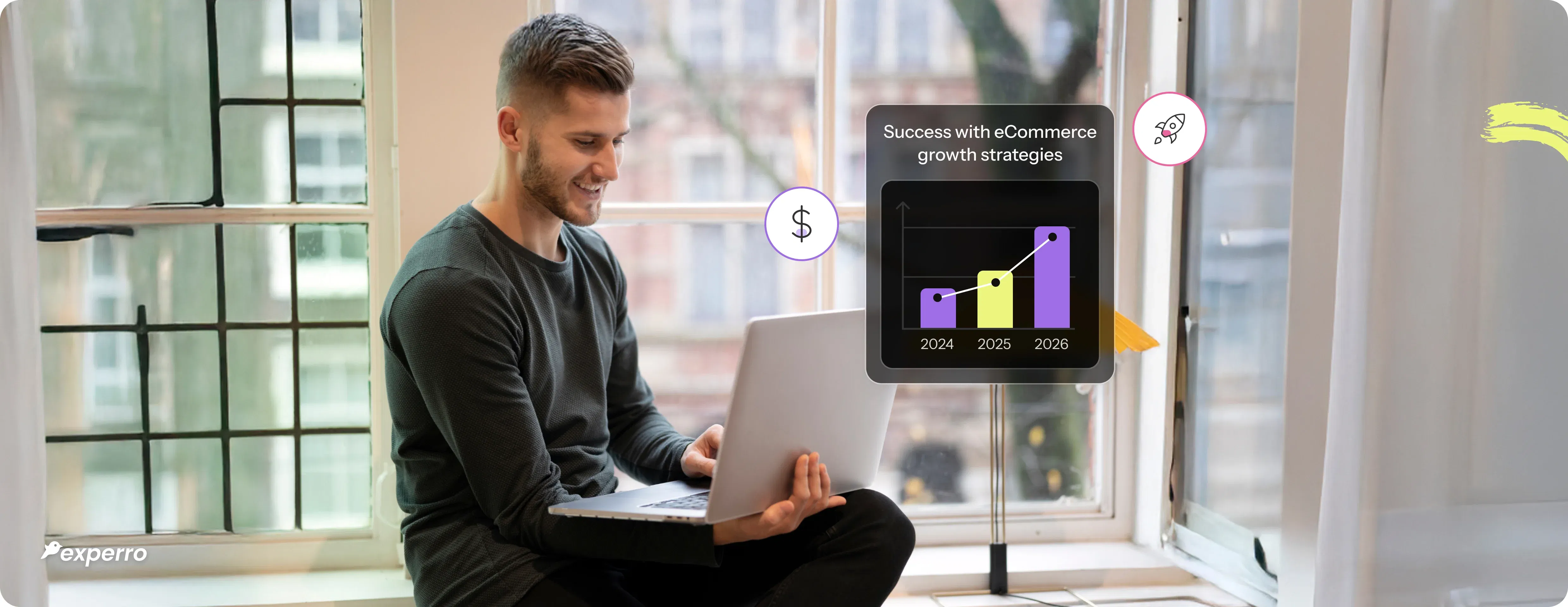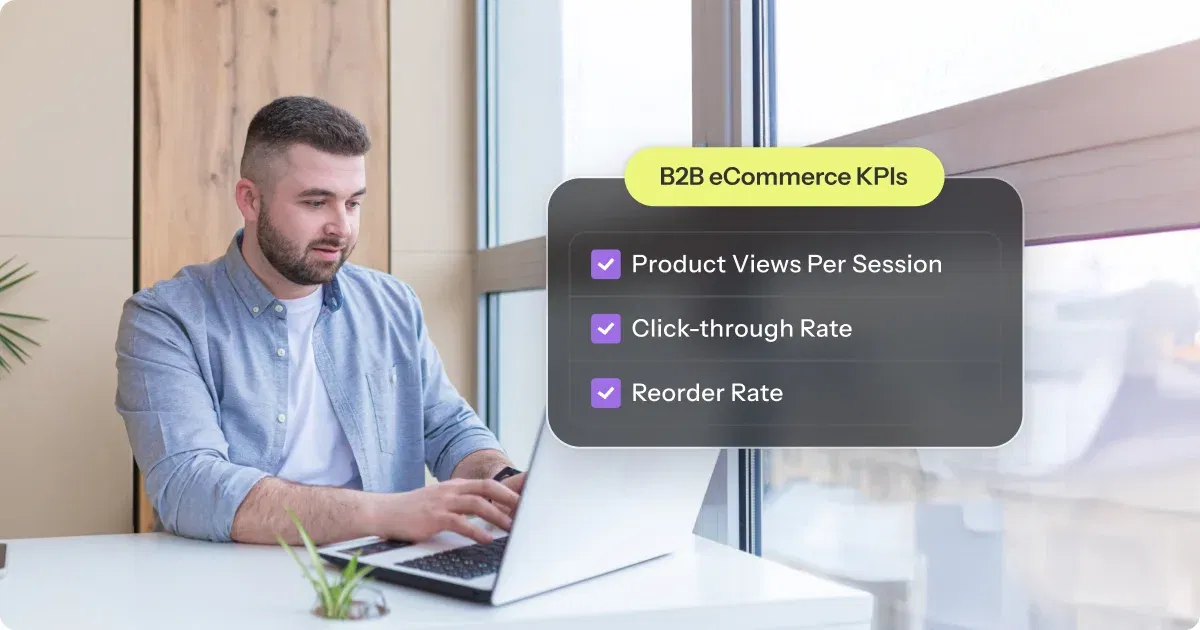- Blog
- Personalization
- eCommerce
- 11 min read
What Is Hyper-Personalization & Why Your Shoppers Love It?
Published
18 June 2024Updated
15 October 2025

core insights box
- eCommerce businesses are shifting from traditional to hyper personalization for more individualized customer experiences.
- Hyper personalization uses real-time data and advanced analytics to predict and meet customer needs.
- Benefits of hyper personalization include higher engagement, increased conversion rates, and improved customer retention.
- Experro provides retailers with top-notch Gen AI-powered search and merchandising features that further help them deliver the best customer experiences.
As a business, is it possible to make every customer feel special?
Yes! But how?
The answer is through hyper personalization. It revolutionizes customer interactions by making every experience personal and tailored.
Hyper personalization makes a shopping experience feel completely tailored to your customers, turning every visit into a personalized experience.
Unlike traditional personalization, hyper personalization goes deeper, tailoring every interaction for the customer.
For example, retail uses shopping behaviors to offer personalized recommendations. The benefits include higher engagement rates, improved satisfaction, and increased conversions, making it a key strategy today.
💡 Want to understand the basics first? Check out our complete guide on What is eCommerce personalization? to learn how tailored shopping experiences drive engagement and sales.
What Is Hyper Personalization?
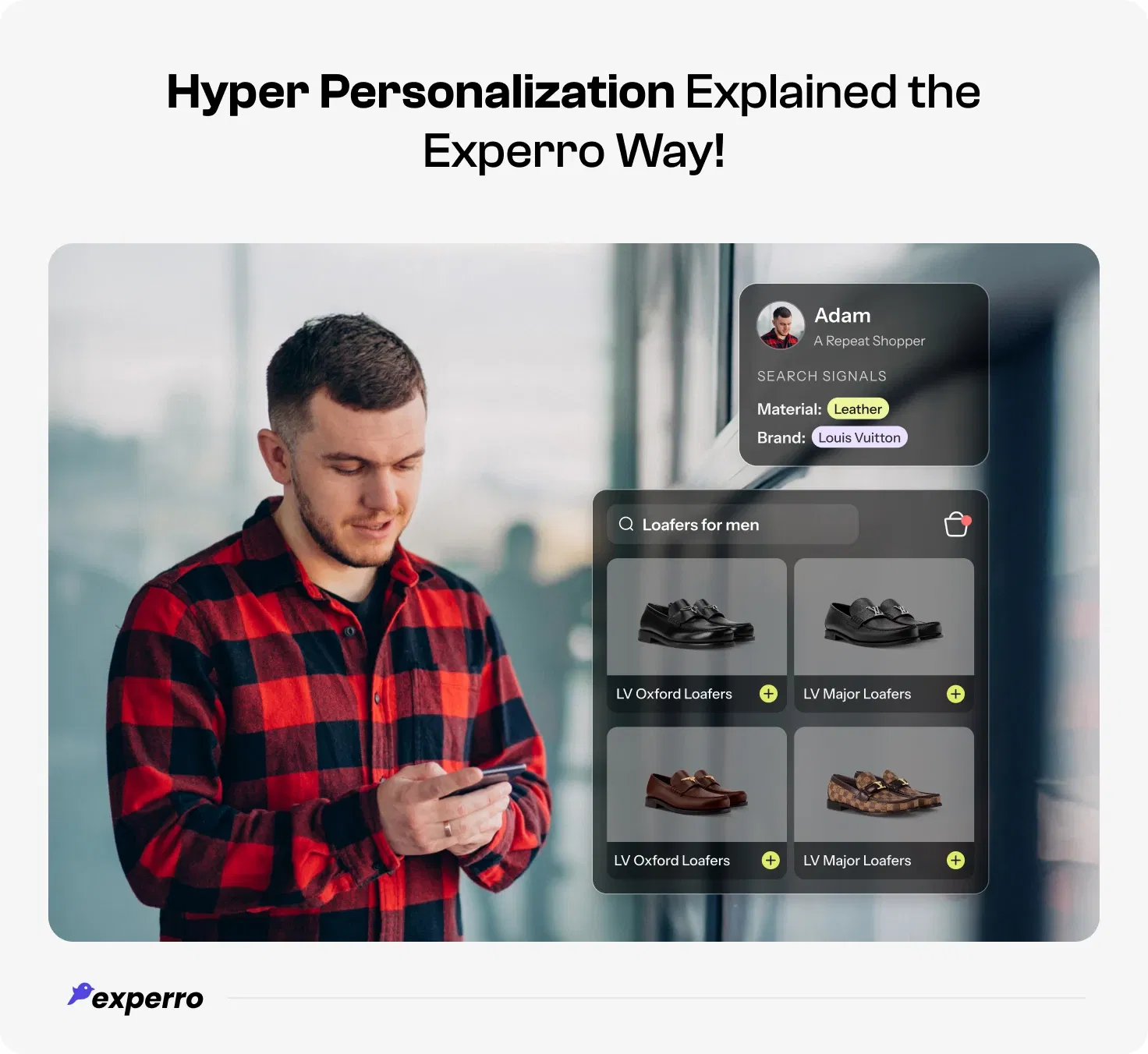
Definition - Hyper-personalization in eCommerce is the use of Gen AI and real-time data to tailor every customer interaction. It creates dynamic experiences that adapt instantly to individual preferences and behaviors.
Unlike traditional personalization which relies on purchase history or static rules, hyper-personalization goes deeper by analyzing intent signals, cross-channel behavior, and even micro-moments to deliver truly individual shopping experiences.
Why Do You Need Hyper-Personalization?
If you are not personalizing the results, then you are simply preparing yourself to lose your customers' interest. Today’s shoppers want experiences that feel unique, relevant, and timely and anything less pushes them toward competitors.
The numbers speak for themselves when it comes to why hyper-personalization matters.
In fact, 86% of businesses report improved results from hyper-personalization, proving its impact on performance. On the other side, 80% of customers say they are more likely to buy from a company that provides a hyper-personalized customer experience.
Let’s break down why hyper-personalization has become so critical in eCommerce:
- Shoppers are overwhelmed with options, and hyper-personalization helps you show what truly matters.
- Attention spans are shorter than ever, so you need to capture interest instantly.
- Buying journeys are no longer linear thus your brand has to adapt at every step.
- Customers move between channels seamlessly, and they expect a consistent experience everywhere.
- Relevance is time-sensitive and what’s important to a customer now may not be five minutes later.
Hyper Personalization vs Personalization: How Are They Different?
In the digital marketing industry, the terms personalization and hyper-personalization are often used interchangeably, but they represent distinct strategies.
Traditional personalization involves tailoring marketing messages based on basic customer data, while hyper-personalization leverages digital experience analytics to deliver highly individualized customer experiences.
This approach goes beyond simple customer segmentation to create a deeply personal and relevant interaction at every touchpoint.
Now, let’s understand hyper personalization vs personalization:
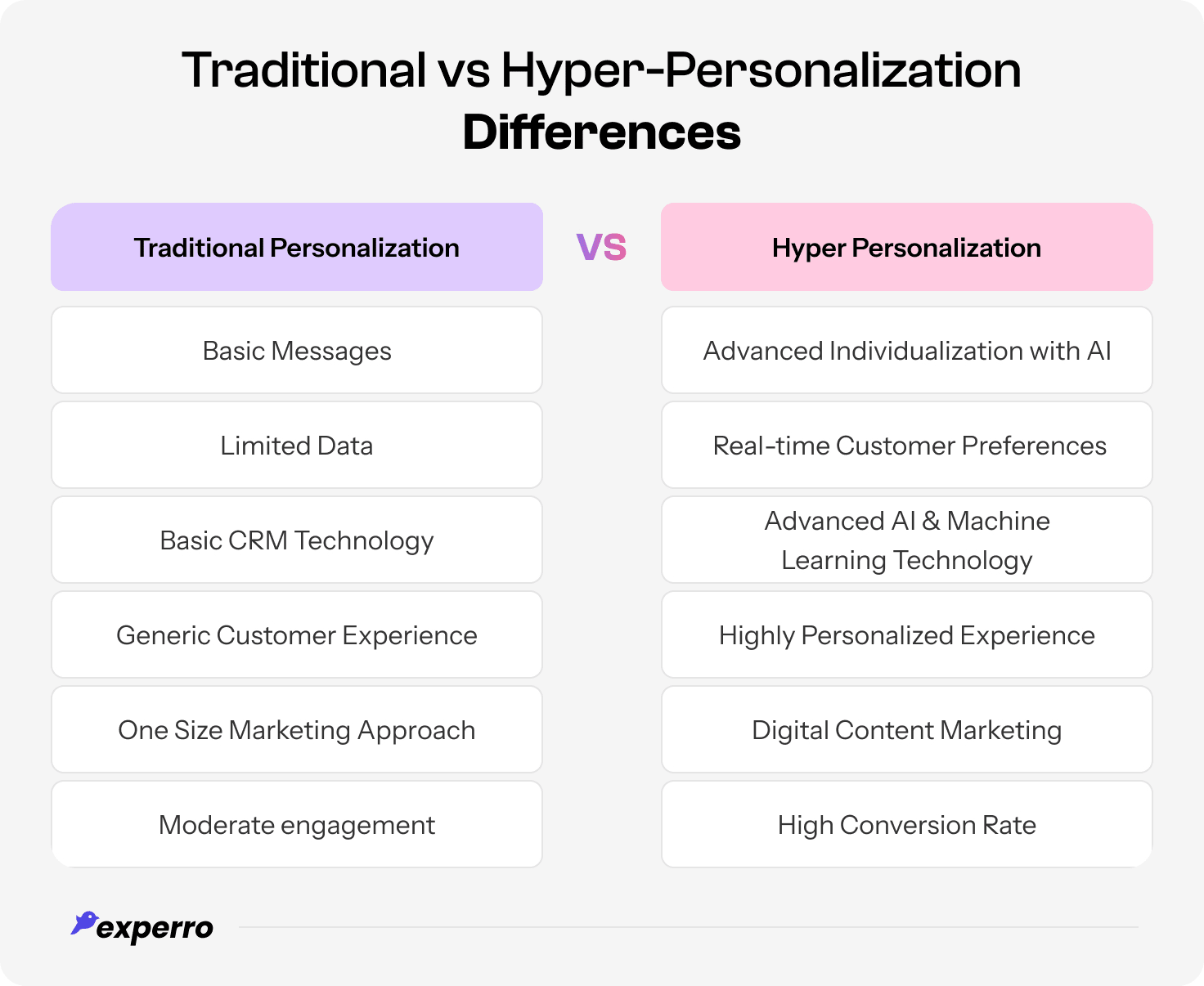
Here is a more detailed version of differences between traditional personalization vs hyper personalization.
Bases of Differences | Traditional Personalization | Hyper Personalization |
| Definition | Basic message customization based on limited customer data. | Real-time, AI-driven individualization that adapts to each shopper’s behavior. |
| Data Utilization | Relies on basic, static data like name and location. | Uses dynamic data, including real-time interactions, past behavior, and purchase intent. |
| Technology | Basic CRM systems and simple rules for targeting. | Powered by AI and machine learning for predictive product recommendations and tailored experiences. |
| Customer Experience | Generic, one-size-fits-all experience that often feels disconnected. | Ultra-relevant, personalized shopping journey, creating deeper connections and higher satisfaction. |
| Benefits | Increases basic relevance but doesn’t deepen customer relationships. | Maximizes AOV, loyalty, and customer lifetime value by delivering personalized, seamless, and frictionless shopping experiences. |
| Effectiveness | Incremental improvement in engagement, but often lacks true relevance. | Maximizes AOV, loyalty, and customer lifetime value by delivering personalized, seamless, and frictionless shopping experiences. |
| Examples | Emails with first names and general product recommendations. | AI-driven product bundles, personalized search results, and individualized offers in real-time. |
The shift from traditional methods to hyper personalization marketing shows the future of customer interaction. As a result, it provides deeper engagement and higher ROI.
What Are the Benefits of Hyper Personalization?
Hyper personalization plays a pivotal role in customer satisfaction.
Unlike traditional personalization, it makes use of AI and real-time data to deliver highly tailored customer experiences.
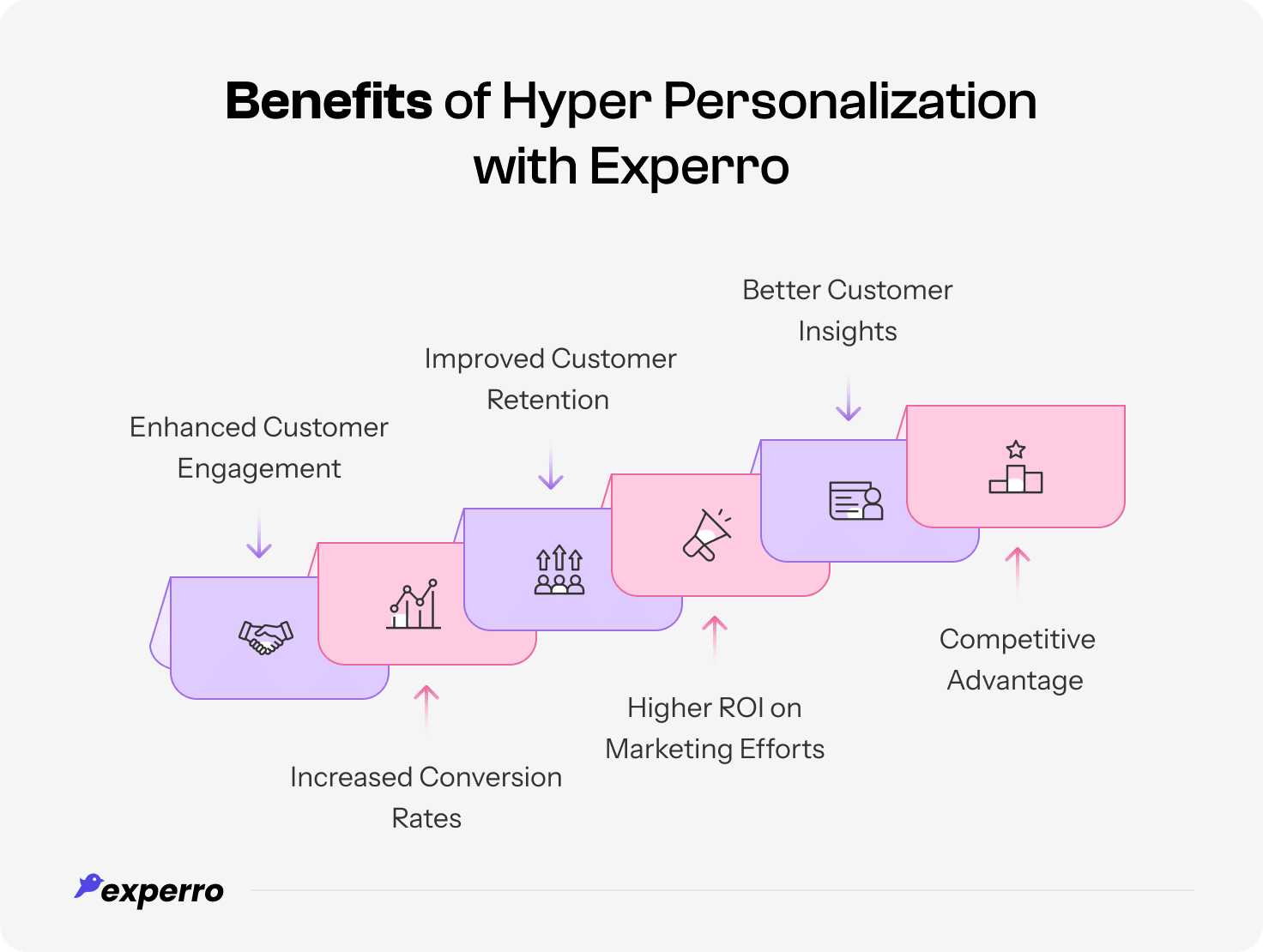
Now, let's understand these benefits in detail:
1. Enhanced Customer Engagement
Hyper-personalization creates more meaningful interactions by offering content and profile-based recommendations that truly resonate with individual customers.
For example, retail hyper personalization uses purchase history and browsing user behavior to suggest relevant products.
This level of engagement ensures customers feel valued and understood, leading to increased loyalty. Hyper-personalization marketing strategies can improve customer experience, satisfaction, and interaction rates.
2. Increased Conversion Rates
Customers are more likely to purchase when they receive relevant product suggestions and personalized offers, thus boosting conversion rates.
Hyper-personalization uses advanced analytics to predict customer needs accurately.
This approach drives sales and enhances the overall shopping experience, making it easier for customers to find what they need.
3. Improved Customer Retention
A hyper-personalized customer experience fosters strong emotional connections with brands.
By continuously delivering tailored experiences, businesses can improve customer loyalty. This retains existing customers and attracts new ones, reducing churn rates significantly.
Additionally, personalized interactions enhance customer satisfaction and drive higher engagement. Ultimately, this leads to increased sales and long-term growth for the business.
4. Higher ROI on Marketing Efforts
Hyper-personalized marketing ensures that marketing efforts are more targeted and effective.
By delivering the right message to the right audience, businesses can maximize their return on investment.
Generative AI-based personalization can automate and optimize these efforts, reducing costs and increasing efficiency. This effect is evident in the improved performance of marketing campaigns, which results in higher revenue.
5. Better Customer Insights
Hyper-personalization capabilities of Experro provide businesses with additional eCommerce analytics for deeper insights into customer behavior and preferences.
This data-driven approach allows companies to fine-tune their personalization tactics.
Our success stories are a testament to how useful hyper-personalization is for e-stores.
6. Competitive Advantage
Staying ahead of your competition is often overlooked. But, just imagine if you could capture your competitor's customer base!
Hopping on to the latest eCommerce personalization trends can definitely help you beat the competition. This exact ability to offer unique, tailored experiences gives you a distinct edge.
Thus, these were the benefits of hyper-personalization with Experro.
What Are the Challenges In Hyper Personalization?
Hyper personalization is pivotal in the eCommerce landscape. However, implementing it comes with several challenges.
According to a Gartner study, brands risk losing up to 38% of their existing customer base due to poor personalization efforts.
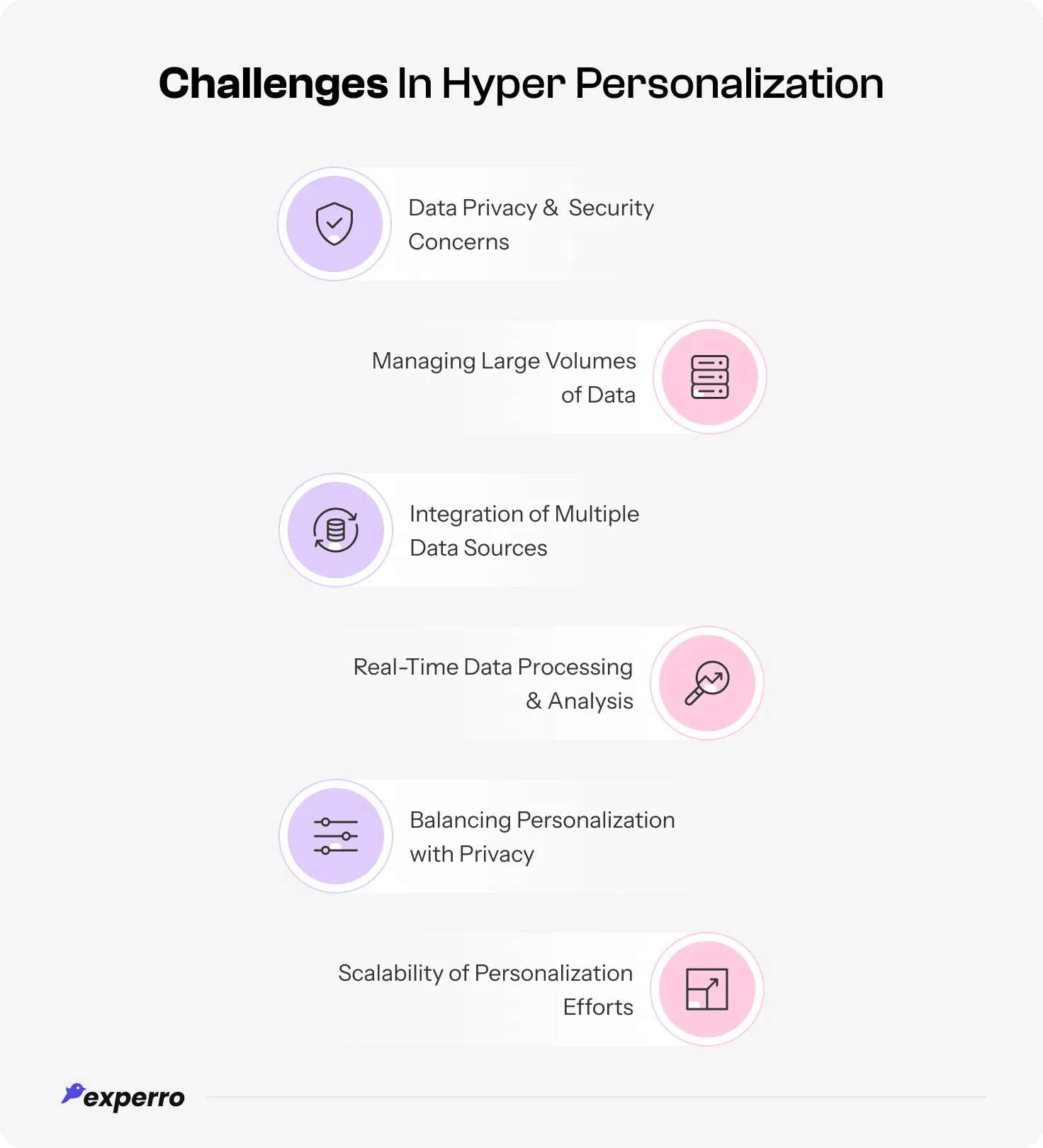
Understanding and overcoming these hurdles is essential to fully leverage the power of hyper-personalization.
1. Data Privacy and Security Concerns for Customer Satisfaction
One of the main challenges of hyper personalization is ensuring data privacy and security. Collecting and using personal data can raise privacy concerns about user privacy. It's crucial to handle data responsibly to maintain trust.
2. Managing Large Volumes of Customer Data
Hyper personalization requires processing massive amounts of data. Managing these large volumes efficiently is challenging. Effective data management systems are needed to handle this data influx.
3. Integration of Multiple Data Sources
Integrating data from multiple sources is essential for hyper personalization customer experience. However, combining data from various platforms can be complex. Ensuring seamless integration is necessary for accurate personalization.
4. Real-Time Data Processing & Machine Learning Analysis
Hyperpersonalization in retail demands real-time data processing and analysis. Quickly analyzing data to deliver personalized experiences is a significant challenge. Experro's advanced Gen AI personalization engine can help manage this in real time.
5. Balancing Personalization with Privacy
Finding the right balance between personalization vs hyper personalization and user privacy is critical. Overly personalized experiences can feel intrusive. It’s important to personalize while respecting user privacy.
6. Scalability of Personalization Efforts
Scaling hyper personalization efforts across large customer bases can be difficult. Hence, scalability solutions are needed to manage personalization at scale.
There have been instances where personalization has gone wrong for businesses due to a lack of understanding of these challenges. Let’s explore the best practices to ensure it’s executed correctly.
Want clarity on how personalized recommendations shape customer journeys? Read the in-depth blog to understand eCommerce Recommendations!
What Are the Best Practices for Hyper Personalization?
According to McKinsey, over 70% of consumers expect hyper personalized experiences and become frustrated when their expectations aren't met.
Hyper personalization goes beyond standard personalization to deliver relevant experiences to individual customers.
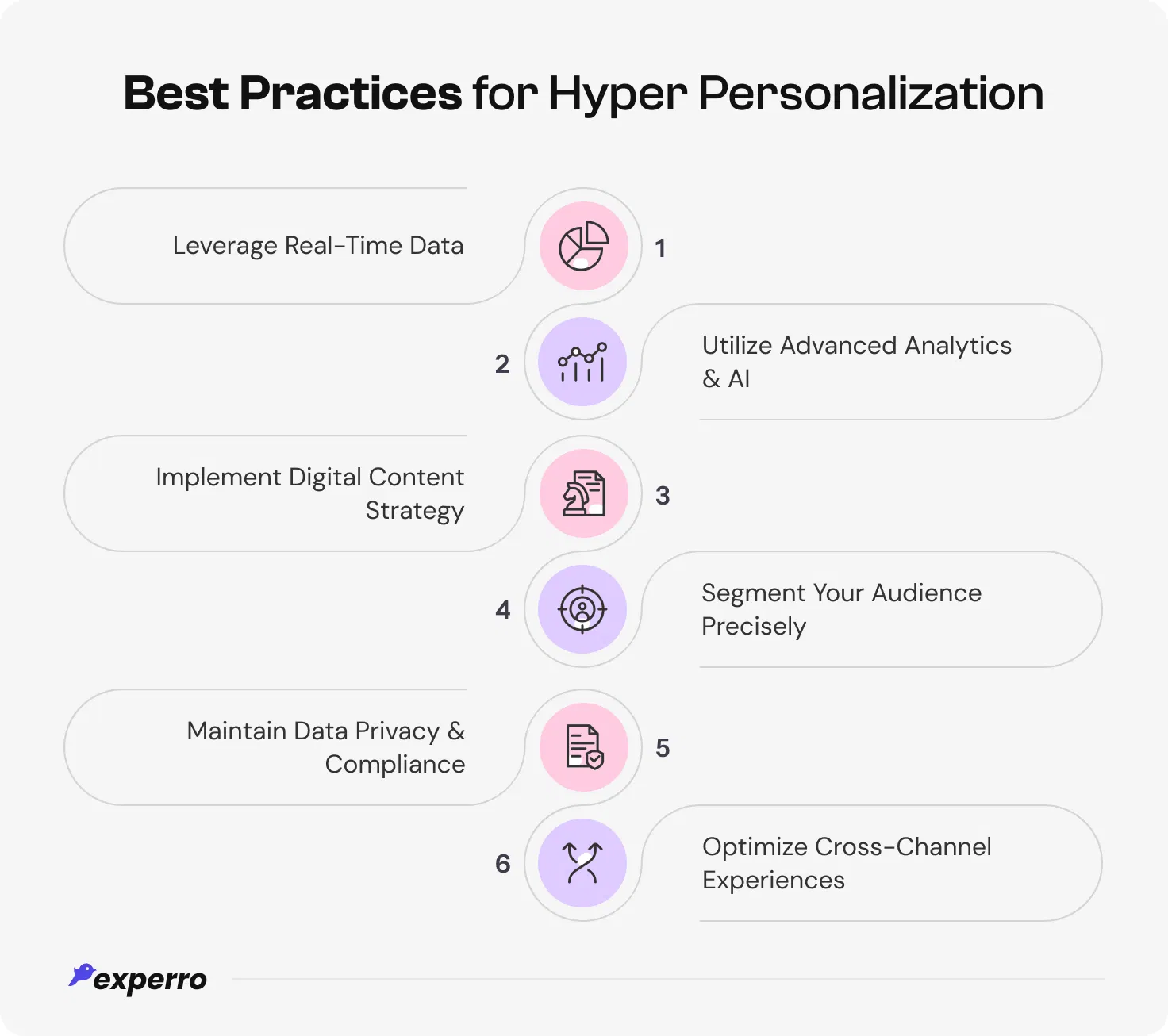
Let's learn more about the best practices for hyper-personalization:
1. Leverage Real-Time Data for Customer Experience
Utilizing real-time data is crucial to complete hyper personalization. It allows you to understand and respond to customer behaviors instantly.
By collecting data from various touchpoints, you can tailor your results to meet the immediate needs of each customer. Leveraging Experro's CDP for hyper-personalization allows businesses to unify this data and activate it across channels, ensuring every interaction feels relevant and timely.
This practice enhances the hyper personalized customer experience, increasing engagement and satisfaction.
2. Utilize Advanced Analytics and AI
Advanced eCommerce analytics tools and AI-powered search are at the core of hyper-personalization marketing.
AI-driven features and tools can predict customer preferences and behaviors, enabling hyper personalized marketing strategies.
It can recommend products that a customer is most likely to buy. The power of hyper-personalization lies in its ability to provide highly accurate and relevant suggestions.
3. Implement Digital Content Strategy
Digital content strategy is the key to implementing hyper-personalization. It involves creating content that changes based on the user’s profile and previous interactions.
This approach ensures that each customer sees the most relevant content. Hyper personalization in retail can use the content to show personalized product recommendations on eCommerce sites.
This strategy improves the user experience hyper personalization and boosts conversion rates.
4. Segment Your Audience Precisely
Precise audience segmentation is essential for effective personalization. You can create targeted marketing campaigns that resonate with each group by dividing your audience into specific segments.
This practice benefits hyper personalization in eCommerce, where different customer segmentation based on unique preferences.
Understanding the differences between personalization and hyper personalization helps craft more precise and impactful messages.
5. Maintain Data Privacy and Compliance
Data privacy and compliance are important in the age of hyper personalization. Customers need to trust that their data is secure and used responsibly.
Ensuring compliance with regulations like GDPR is critical. This practice not only protects your business but also builds customer trust.
Highlighting your privacy and consent management commitment can enhance the hyper personalized customer experience.
6. Optimize Omnichannel Experiences
Optimizing omnichannel experiences in eCommerce is vital for hyper personalization. Customers interact with leading brands across various channels, and ensuring a seamless experience is crucial.
Omnichannel hyper personalization in marketing should provide consistent and relevant interactions, whether the customer is on a website, app, or social media.
This unified approach enhances the overall hyper-personalized content, driving better customer loyalty and satisfaction.
An Example Of Hyper-Personalization In Retail
Hyper-personalization is transforming the way businesses interact with their repeat customers. It provides highly tailored experiences that drive engagement and sales.
For brands wondering how to implement hyper personalization, the key lies in leveraging data, AI, and intelligent search to ensure every touchpoint is relevant.
Hyper personalization examples can help illustrate this: For example, if a user is looking for knee-length red dresses, the search algorithm works towards showing the user exactly that. The search results are displayed on the basis of affinities that the customer's search behavior tells.
How Can Experro Help You Bring Hyper-Personalization to Your Brand?
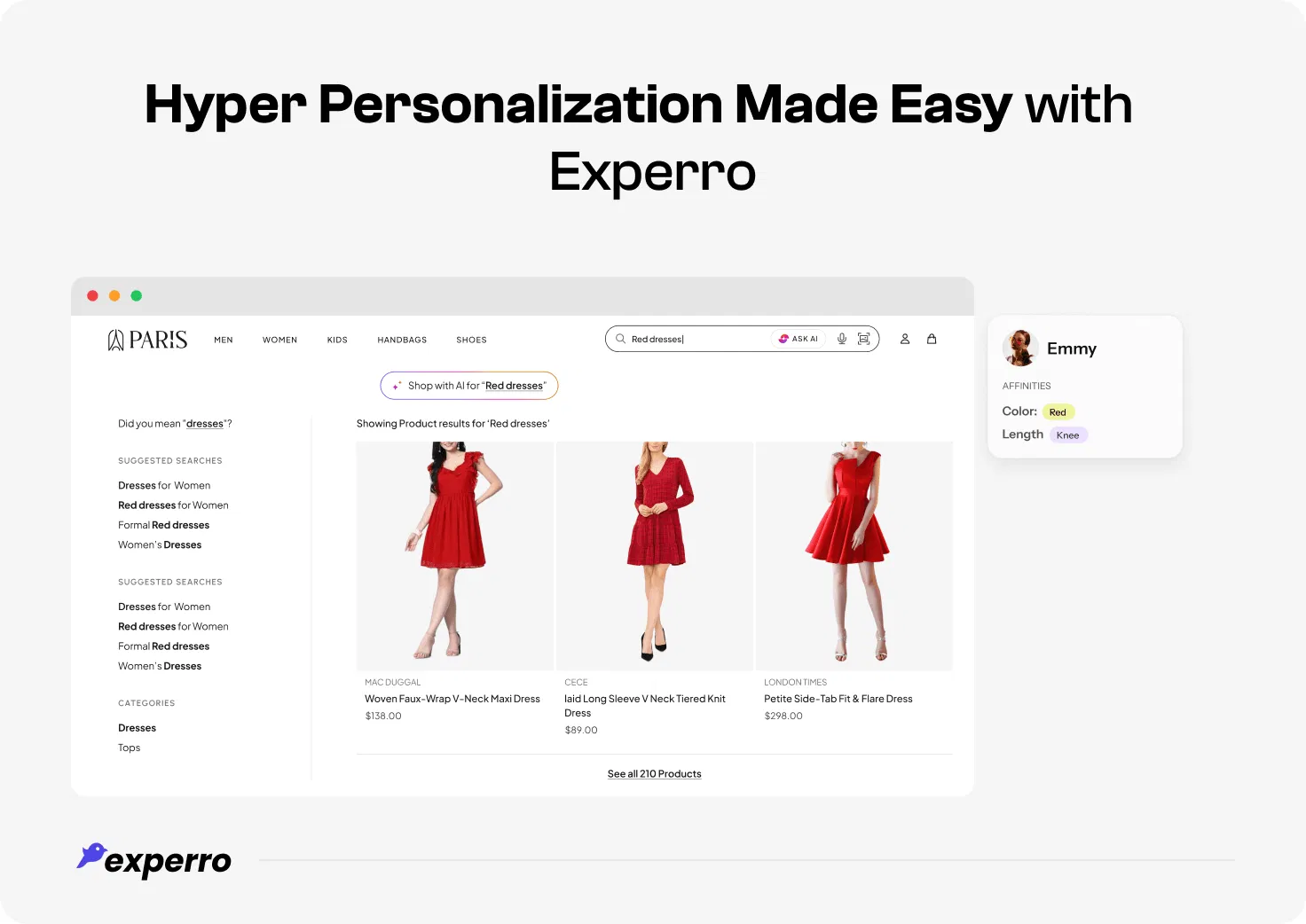
Experro is an Agentic Experience Platform designed to redefine how brands deliver hyper-personalization in eCommerce.
At its core, Experro combines Gen AI-powered search with real-time hyper-personalization engine, creating a unified experience where every interaction feels tailored to the individual shopper.
This makes product discovery faster, search results more accurate, and recommendations more relevant, turning browsing into buying.
For businesses, Experro provides more than just personalization, it offers deep analytics and optimization tools that make it easy to measure performance and scale strategies across all channels.
The outcome is a powerful combination of intelligent search, contextual recommendations, and actionable insights that drive higher engagement, stronger loyalty, and measurable revenue growth.
Discover how Experro's hyper-personalization can elevate your eCommerce success to new heights!
Conclusion
In conclusion, hyper personalization approach goes beyond traditional methods, offering tailored interactions that increase satisfaction and conversions.
With AI-driven personalization, businesses can analyze customer needs and optimize interactions.
Experro, as a complete agentic experience platform, enhances this by using data analytics to tailor search results and product suggestions. The platform also ensures that every customer interaction is meaningful and valuable.
Stay tuned for further updates, or schedule a call with our team for a one-on-one discussion!
FAQS
Can hyper-personalization enhance customer engagement?
Yes. By delivering timely, relevant content across touchpoints, hyper-personalization for enhanced customer engagement increases interaction, dwell time, and brand loyalty — leading to stronger customer relationships.
Is hyper-personalization effective in eCommerce?
Absolutely. Hyper-personalization in retail and e-commerce boosts conversions, reduces cart abandonment, and drives repeat purchases through personalized offers, product suggestions, and tailored journeys.
Does hyper-personalization raise privacy concerns?
Yes. Since it relies on customer data for hyper-personalization, transparency and consent are critical. Brands must comply with privacy regulations and clearly communicate how data is used to build trust.
How does hyper-personalization help in sales?
It increases sales by delivering hyper-personalized recommendations and offers based on buying intent. This relevance shortens the path to purchase, improves upselling and cross-selling, and drives higher ROI.
How to use hyper-personalization?
Start by unifying customer data, applying AI models, and defining your hyper-personalization strategy across web, app, and marketing channels. Continuously test and refine experiences for better engagement and conversions.
Pallavi Dadhich
Content Writer @ ExperroPallavi is an ambitious author recognized for her expertise in crafting compelling content across various domains. Beyond her professional pursuits, Pallavi is deeply passionate about continuous learning, often immersing herself in the latest industry trends. When not weaving words, she dedicates her time to mastering graphic design.
What's Inside
- What Is Hyper Personalization?
- Why Do You Need Hyper-Personalization?
- Hyper Personalization vs Personalization: How Are They Different?
- What Are the Benefits of Hyper Personalization?
- What Are the Challenges In Hyper Personalization?
- What Are the Best Practices for Hyper Personalization?
- An Example Of Hyper-Personalization In Retail
- How Can Experro Help You Bring Hyper-Personalization to Your Brand?
- Conclusion
Subscribe to Our Newsletters
Get the latest insights delivered straight to your inbox.
